Possession in wide areas
The session is about possession, with a particular focus on getting the ball out wide.
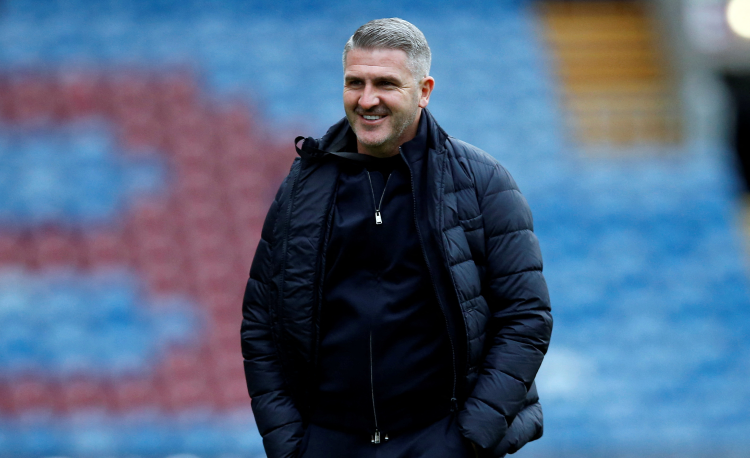
| Area | Up to 40x50 yards |
| Equipment | Balls, bibs, cones, mini goals, 2 full size goals |
| No. of Players | Up to 16 outfield + 2 goalkeepers |
| Session Time |
3v3+4: 12mins |
The session is about possession, with a particular focus on getting the ball out wide. It progresses from an initial warm-up, through to small-sided games with neutral players – 3v3s and 6v6s – before moving on to a 3v3 break-out attack wave game and finishing with a 9v9 with two neutral outside players.
The possession aspect of this exercise is unique. The session can be tweaked and adapted to suit specific outcomes or to prepare to play against a certain opposition.
One particular time we ran this session, we were preparing to play a side renowned for possession football, an opposition team who liked to keep the ball and maximise their touches. We ran this session with some restrictions which meant the players had to get a set number of passes in before getting a shot at goal. In the small-sided games, we had a goal at one end and a bounce player at the other end, so we could use them to get passes in before reaching the goal.
We also asked players to break out into wide areas to attack, using 1v1s, 2v2s and 3v3s. For the 9v9 at the end we used the wing-backs as the outside players, we could get the ball out wide, and encourage them to deliver some crosses.
This session would start the week’s possession work. In a typical week without a midweek fixture, this would be a Tuesday session. We’d have a day off on Wednesday, work out of possession on the Thursday, then work in possession on the Friday.
“One time we ran this session, we were preparing to play a side renowned for possession football”
3v3+4
We set up some 10x10-yard squares – as many as are needed to get all players involved – with a mini goal set back from each. The reds and blues play 3v3 in the area. The yellows are the neutral team – with one player inside the area and three positioned around the outside, as shown.
The team in possession of the ball can use the neutrals to keep the ball [1a].
[1a]
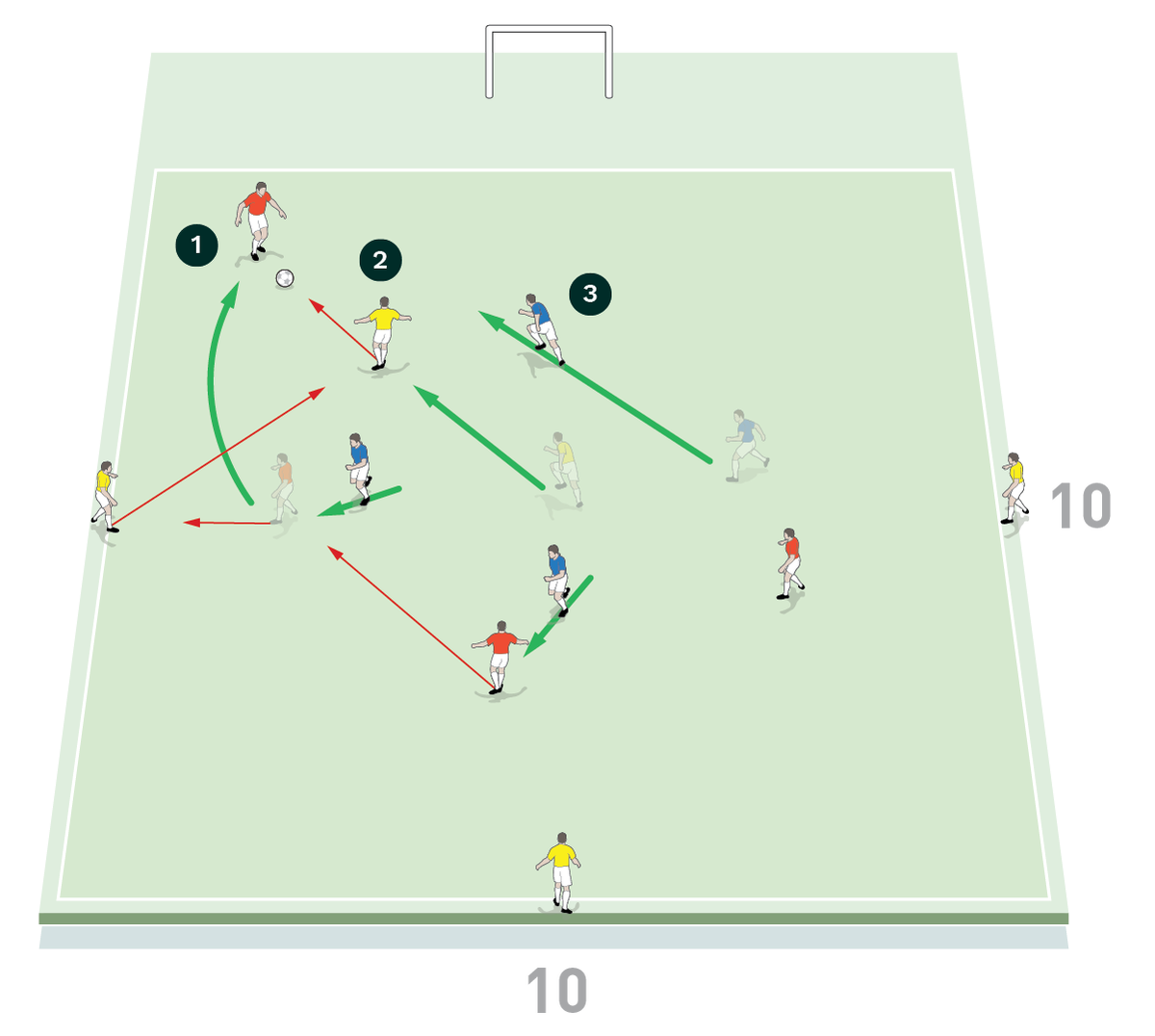
-
The red team are in possession and look to make eight passes to gain a point
- The neutral players assist the team in possession, and are limited to two touches
- The blue team look to win the ball back
The neutrals are limited to a maximum of two touches. The in-possession team must achieve eight passes to gain a point.
The out of possession team must look to win the ball back. If they do so, they can score in the mini goal [1b].
[1b]

-
The blue team wins the ball back
- They score in the mini goal to gain a point
We run this for six rounds of 90 seconds each, alternating the in-possession team each time.
“The in-possession team must achieve eight passes to gain a point”
6v6
We set up a 20x16-yard area. The reds and blues play 6v6 in the middle. The yellows are the neutral team – with two players inside the area and six positioned around the outside, as shown.
The team in possession must keep the ball, with ten passes equalling a goal, and can use the neutrals to do so. The neutrals are limited to a maximum of two touches. The team out of possession should look to win the ball back. When they do win the ball back, they now look to keep it, using the neutrals to do so [2].
[2]
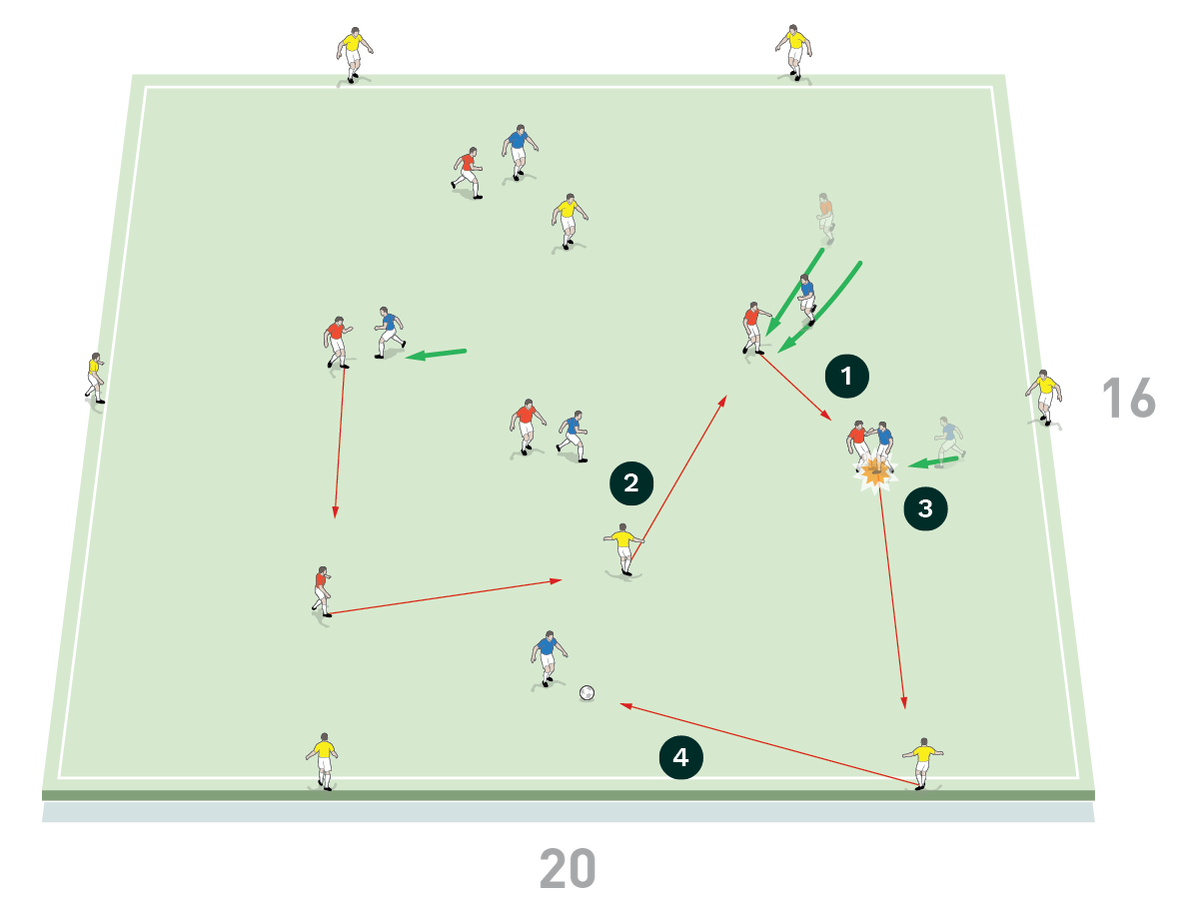
-
The red team are in possession and look to make ten passes to gain a point
- The neutral players assist the team in possession, and are limited to two touches
- The blue team win the ball back
- The blues are now in possession and use the neutrals to help them make ten passes
WAVE GAME
We set up a 20x30-yard area with a halfway line and a full size goal at each end, with a goalkeeper in each. There are nine players per team – three start on pitch, and six start off pitch, as shown.
One team of three attacks, while the other looks to win the ball back. Each time a goal is scored [3a] the three players that conceded the goal leave the pitch to be replaced with three other members of their team.
[3a]

-
Three reds and three blues start on pitch
- The red team start with the ball and attack
- The blue team wins the ball back and scores
The players that remain on pitch now defend [3b].
[3b]
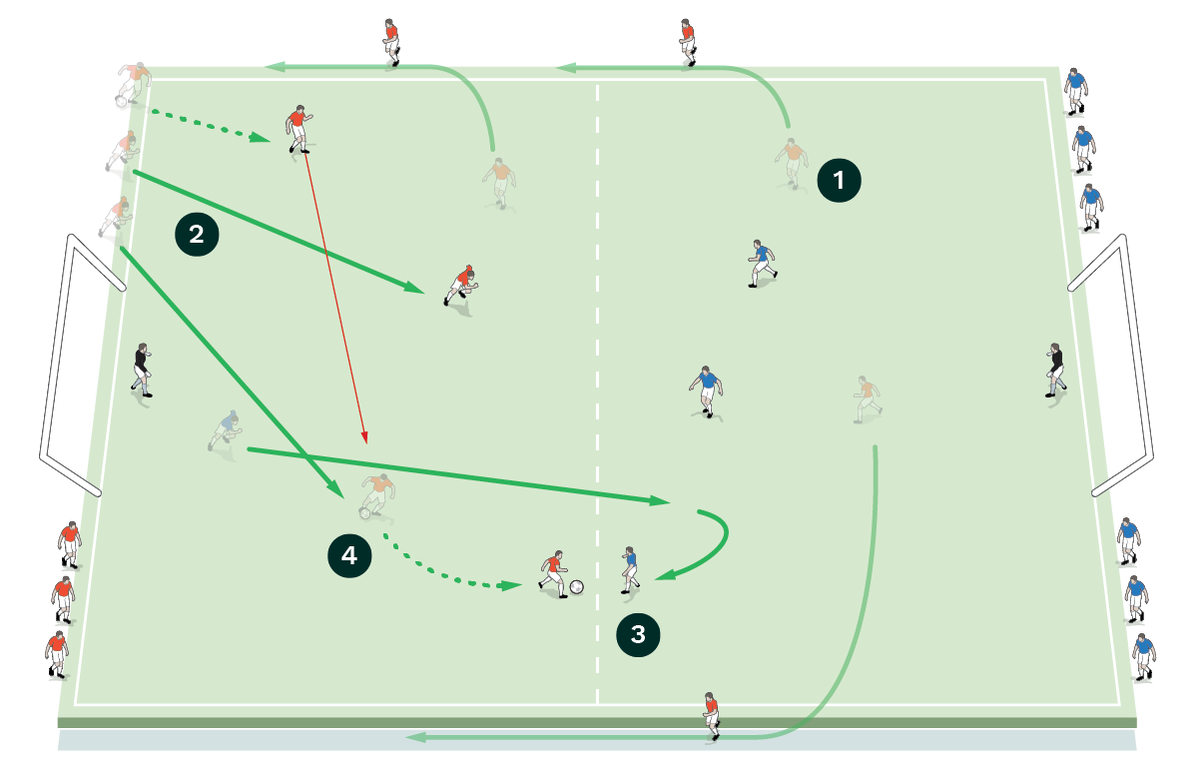
-
The red team leaves the pitch
- The reds are replaced by three of their team-mates
- The blue team gets back into position to defend
- The red team attacks
When in possession, we want players to attack quickly and make use of overlaps and underlaps. When out of possession, we want players to defend by showing their counterparts wide, and making blocks and tackles.
We run this for two blocks of four minutes each.
9v9
We set up a 40x50-yard area with a halfway line and a full size goal at each end, with a goalkeeper in each. There are nine outfield players per team, and two neutrals, positioned as shown.
Teams work to score a goal, using the neutrals to do so. The neutrals are wide players, limited to a maximum of two touches, and the team in possession is encouraged to play the ball wide to allow for crosses [4a] or let the wide player play back through the central defensive midfielder.
[4a]
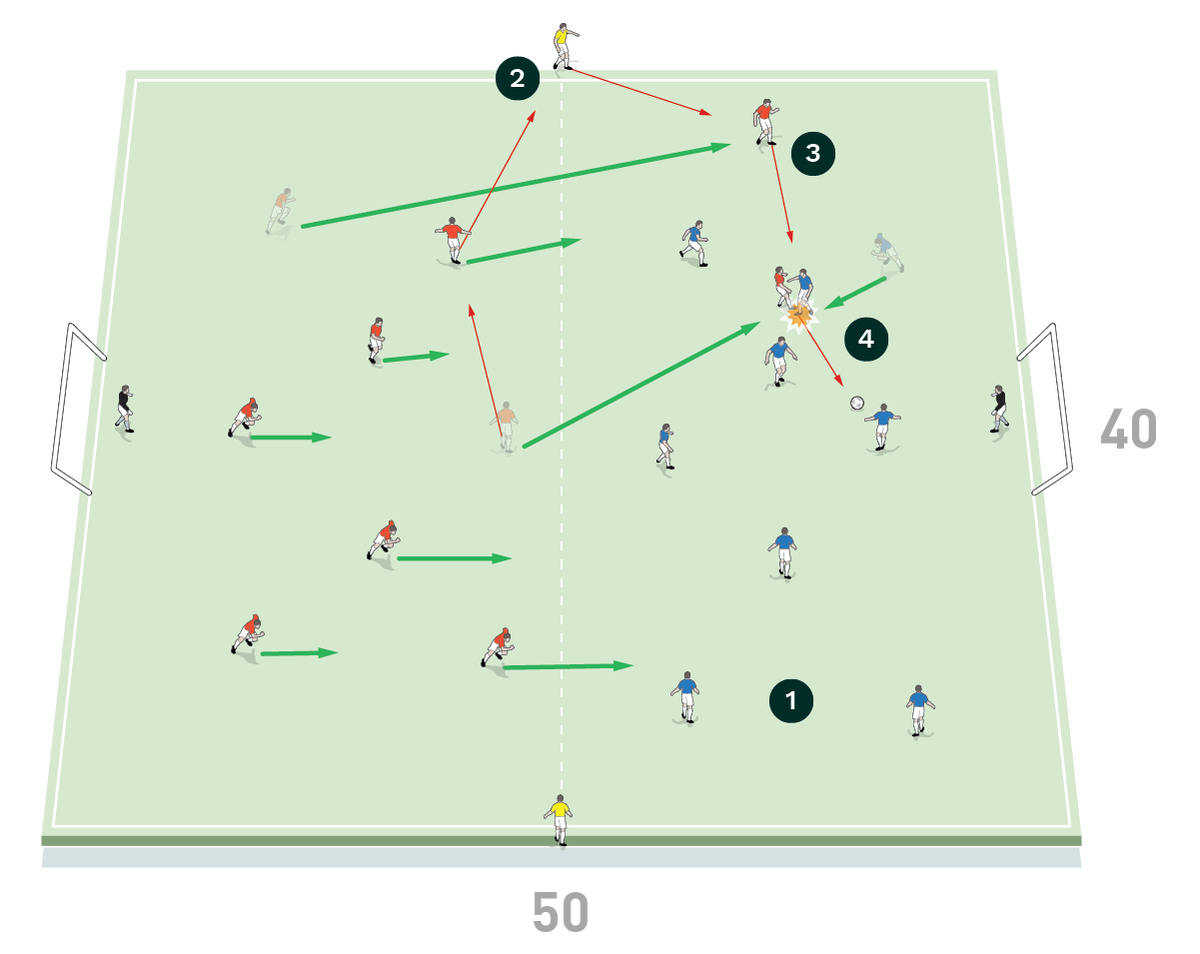
-
The reds and blues play 9v9 in the area
- The wide neutral players on the outside are limited to two touch
- The red team uses the neutral players to work the ball into their attacking half
- The blue team win the ball back
The opposition must win the ball back to do the same – when they are in possession, they have use of the neutral players.
Zones can be added in to include extra stipulations. For example, if the ball is played forward from the defending half into the attacking half, the in possession team cannot play it back, it must remain in the attacking half until the end of the play [4b].
Other stipulations, such as needing to complete or three or four passes before you pass forward can also be added.
We run this for 15 minutes.
[4b]

-
The blue team now attack
- The blue defender plays a ball from the defensive half into the attacking half. The ball cannot come back into the defensive half while the blues retain possession due to an added zone rule
- The red team work to recover the ball
- The blue team score a goal
COACHING POINTS
What are the key things to look for?
It is about getting the ball and taking as few touches as possible to get the ball out wide, then looking at deliveries.
Technically, it is about making sure we can get some good balls into the box, whether it’s pull-backs, deep crosses or high crosses, while making sure players enter the box at the right time.
Tactically, it’s being aware that when you are attacking, you can also defend, but also how many passes you can get in before you get the ball wide, and how we can build from one side to the other.
Editor's Picks
Attacking transitions
Deep runs in the final third
Using the goalkeeper in build-up play
Intensive boxes drill with goals
Penetrating the final third
Creating and finishing
My philosophy
Pressing initiation
Compact team movement
Coaches' Testimonials

Alan Pardew

Arsène Wenger

Brendan Rodgers

Carlos Carvalhal

José Mourinho

Jürgen Klopp

Pep Guardiola

Roy Hodgson

Sir Alex Ferguson

Steven Gerrard
Coaches' Testimonials

Gerald Kearney, Downtown Las Vegas Soccer Club

Paul Butler, Florida, USA

Rick Shields, Springboro, USA

Tony Green, Pierrefonds Titans, Quebec, Canada
Join the world's leading coaches and managers and discover for yourself one of the best kept secrets in coaching. No other training tool on the planet is written or read by the calibre of names you’ll find in Elite Soccer.
In a recent survey 92% of subscribers said Elite Soccer makes them more confident, 89% said it makes them a more effective coach and 91% said it makes them more inspired.
Get Monthly Inspiration
All the latest techniques and approaches
Since 2010 Elite Soccer has given subscribers exclusive insight into the training ground practices of the world’s best coaches. Published in partnership with the League Managers Association we have unparalleled access to the leading lights in the English leagues, as well as a host of international managers.
Elite Soccer exclusively features sessions written by the coaches themselves. There are no observed sessions and no sessions “in the style of”, just first-hand advice delivered direct to you from the coach.









